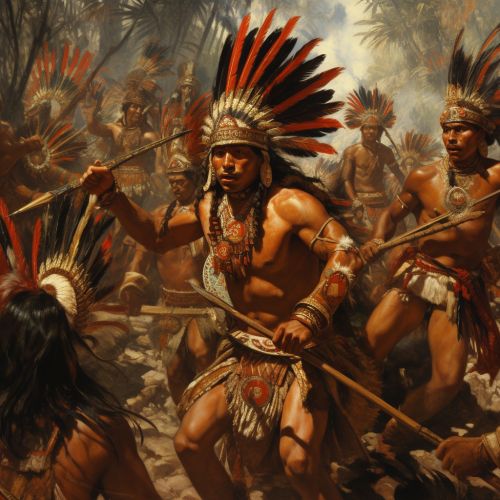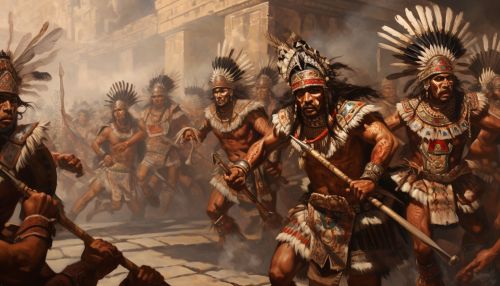Aztec Warfare
Introduction
The Aztec were a Mesoamerican culture that flourished in central Mexico in the post-classic period from 1300 to 1521. A significant aspect of their culture was their approach to warfare and military structure, which was deeply intertwined with their religious beliefs, social structure, and economy. This article will delve into the intricacies of Aztec warfare, providing a comprehensive and detailed analysis of their military tactics, weaponry, and the role of warfare in Aztec society.


Military Structure and Organization
The Aztec military was a highly organized and structured institution. The basic unit of the Aztec military was the calpulli, which was a group of families related by blood or living in the same neighborhood. Each calpulli was responsible for providing a certain number of warriors for the military, and these warriors were trained from a young age in the arts of warfare and religion.
The military hierarchy was based on merit, with warriors advancing in rank based on their performance in battle. The highest rank a warrior could achieve was that of the Eagle or Jaguar warrior, both of which were considered elite warriors and held a high status in Aztec society. These warriors were distinguished by their unique battle attire, with Eagle warriors wearing feathered helmets and Jaguar warriors donning jaguar pelts.
Military Training
Military training in Aztec society began at a young age. Boys were taught the basics of warfare and religion at the calmecac, a type of school run by priests. At the age of fifteen, they would enter the telpochcalli, or youth house, where they would receive more advanced training in warfare, as well as lessons in civic duty and morality.
Training was rigorous and discipline was strictly enforced. Young warriors were taught to endure hardship, and physical punishment was a common method of discipline. They were also taught the importance of bravery and honor in battle, and were expected to display these qualities at all times.
Tactics and Strategies
Aztec warfare was characterized by its emphasis on hand-to-hand combat. The Aztecs did not have access to horses or advanced weaponry, so their tactics were largely based on close-quarters combat. They made extensive use of ambushes and surprise attacks, and would often attempt to surround and overwhelm their enemies.
The Aztecs also made use of psychological warfare. They would often engage in ritualistic pre-battle ceremonies, which included the sounding of drums and conch shells, and the display of banners and flags. These ceremonies were designed to intimidate their enemies and boost the morale of their own troops.
Weaponry
The Aztecs used a variety of weapons in battle, many of which were unique to their culture. The macuahuitl, a sword-like weapon with obsidian blades, was one of the most common weapons used by Aztec warriors. They also used atlatls, spear-throwers that could launch darts with great force and accuracy. Other weapons included bows and arrows, slings, and clubs.
Armor was also an important part of Aztec warfare. Warriors wore ichcahuipilli, a type of padded cotton armor, and carried chimalli, round shields made of reeds and decorated with feathers and animal skins.
Role of Warfare in Aztec Society
Warfare played a central role in Aztec society. It was deeply intertwined with their religious beliefs, as the Aztecs believed that the gods required human blood to sustain them. As a result, many battles were fought for the purpose of capturing prisoners for human sacrifice.
Warfare also played a key role in the Aztec economy. Conquered territories were required to pay tribute to the Aztecs in the form of goods and labor, which helped to sustain their empire. Additionally, successful warriors were rewarded with wealth and status, providing a strong incentive for participation in warfare.
Conclusion
Aztec warfare was a complex and multifaceted aspect of their society, deeply intertwined with their religious beliefs, social structure, and economy. Their military tactics, weaponry, and the role of warfare in their society provide a fascinating insight into this ancient civilization.
